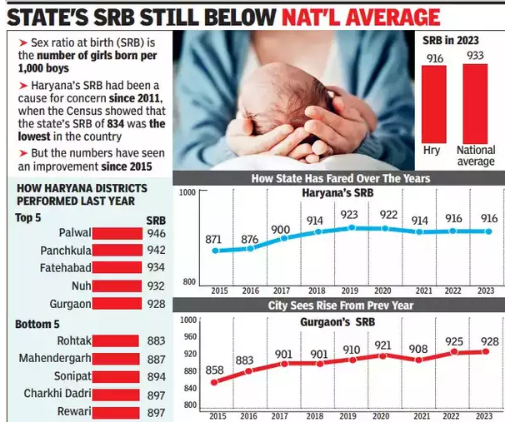TAG: GS-2: SOCIAL ISSUES & HEALTH
CONTEXT: The sex ratio of Haryana, which is notorious for female feticides, has reached its lowest level in the last eight years. This information has been released from the recent data released by the state government.
EXPLANATION:
- Since the 2011 Census, the gap between boys and girls in Haryana has been a cause for concern. The state’s sex ratio at birth of 834 is the lowest in the country, which led to the state launching a stringent crackdow against female foeticide.
- Sex ratio at birth (SRB) declined in 16 of Haryana’s 22 districts. However, the state’s overall SRB remained stable at 916
- Northern and central districts like Sirsa, Fatehabad, Sonipat, Yamunanagar, Hisar, Bhiwani, Rohtak, Jind and Charkhi Dadri witnessed a decline in the number of girls born.

-
- In 2015, from 858, the state’s sex ratio at birth climbed to 883 in 2016, followed by 901 in 2017.
- It remained the same in 2020 but improved to 923 in 2018.
- After that, it saw a dip again from 921 in 2020 to 908 in 2021.
- At 925, the SRB showed a slight improvement in 2022 and continued to stay in the same mark 2023 as well.
- Haryana has historically struggled with gender imbalance due to practices such as female foeticide, driven by deep-rooted patriarchal norms and a preference for male heirs. SRB in Haryana has shown improvement in recent years thanks to government interventions, but this decline indicates a possible reversal.
- India’s overall SRB has been a major concern, with disparities rooted in socio-economic factors and cultural biases.
What a Reasons for low sex ratio in Haryana?
The primary reason for Haryana’s low sex ratio is a deep-seated cultural preference for male children rooted in traditional and patriarchal values. This preference has led to practices like female foeticide and gender-biased sex selection, which are often driven by socio-economic factors, such as:
-
- Patriarchal Norms and Family Lineage: In many communities, sons are viewed as carriers of the family name and providers of financial and social security, especially in old age. Daughters, on the other hand, are often seen as a financial burden due to dowry practices and the perception that they will eventually leave the family after marriage.
- Economic Factors and Dowry: The economic burden associated with raising daughters—especially due to dowry customs—adds to the preference for sons. Sons are seen as future income earners and inheritors, while daughters are perceived as a liability, despite legal protections against dowry.
- Weak Enforcement of Anti-Foeticide Laws: Laws like the Pre-Conception and Pre-Natal Diagnostic Techniques (PCPNDT) Act, aimed at preventing sex-selective abortions, are not always strictly enforced, particularly in rural areas. Some medical practitioners may also exploit loopholes or participate in unethical practices for financial gain.
- Access to Sex-Selective Technology: The availability and misuse of ultrasound and prenatal testing technologies have made it easier to identify and selectively abort female fetuses, particularly in communities where there is a strong preference for male children.
- Slow Pace of Social Change: Although initiatives like Beti Bachao Beti Padhao have made some progress, deeply rooted beliefs about gender take time to change, and societal transformation is gradual.
Conclusion:
Haryana’s low sex ratio is a product of traditional gender biases reinforced by economic considerations and the slow pace of social and cultural change. Addressing this issue requires comprehensive solutions, combining strict enforcement of laws with cultural shifts through education, economic empowerment of women, and continuous efforts to promote gender equality.
Source:
Spread the Word
